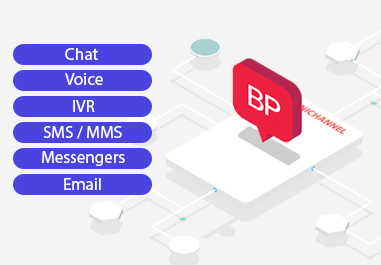Without a doubt, the future of customer service is omnichannel. In fact, according to a recent study, 9 out of 10 customers demand omnichannel support.
Omnichannel contact centers make client support easier by seamlessly connecting all channels (e.g., text, email, chat, voice, etc.). An omnichannel platform connects all of these channels into one, seamless conversation which can be followed easily by the agents. This leads to a better experience for both agents and customers during conversations, since customers and agents experience less friction during the interaction even as it’s jumping between channels.
However, to obtain all of these benefits and more, a smooth rollout of an omnichannel platform into your contact center is key. In order to avoid overwhelming your customer support team and achieve your contact center goals, ample preparation and training for implementing your omnichannel solution (and the planned migration process) is key.
Read on and learn what omnichannel does best and how to make it work for agents and customers with real-world examples.
What Does an Omnichannel Customer Experience Look Like?
An omnichannel customer experience connects all customer touchpoints over many channels, so customers can pick up where they left off and continue the process elsewhere. These channels include traditional ones like voice and email, as well as digital ones like video, webchat, SMS, text messaging, messenger apps, and more.
Building Personalized Experiences
With omnichannel software, agents work with clients to create a personalized experience across every platform. By understanding who clients are and what they’re going through, contact center agents are friends rather than nameless voices.
Consistent Service Across All Platforms
Omnichannel’s integration makes customer service consistent across all platforms. For example, a customer might end a support call on the phone and continue the conversation through email the next day. Using an omnichannel contact center solution like Bright Pattern gives agents all the details of previous exchanges, creating a seamless and consistent experience because the customer can start the conversation right where they left off and the agent can easily follow along.
Engaging Support
Omnichannel contact centers integrate with CRM to provide engaging customer experiences.
Each inbound caller has a full profile which agents use to give personalized support. For example, when a customer calls in, agents know the client’s name, company, communication history, and more. This is because on a CRM integration, the information from the record management system is popped up on the screen, giving agents easy access to customer information at their fingertips. Effective contact centers encourage agents to use CRM info to create meaningful customer interactions—making agents and customers feel valued.

How to Train Agents for Omnichannel Customer Service
Omnichannel’s worthless without a support team that understands it. So when training your agents for the omnichannel customer experience, keep these principles in mind:
Understand Your Customer Journey
Effective support starts with understanding your customer’s habits. Your agents need to know:
- Your ideal customer persona: What’s your firm’s common demographic? Job? Stage of life? Location?
- Your customers’ favorite channels: How do your clients most often contact support? Phone? Email? Live chat?
- Customer touch points: How do clients interact with your brand?
- Customer pain points: What stops prospects from using your services? What problems do they commonly face during their experience?
Agents who understand your customers can guide every step of the buyer’s journey.
Provide Full Guidance
Agents can’t provide adequate support without thorough education. Teach them all about dealing with customers, including:
- Tech training: Make sure your agents know how your omnichannel system works.
- Agent handover: One of the main benefits is seamless movement between qualified agents. With that in mind, ensure your agents know when and how to switch clients to another agent.
- Proper tone: Teach agents to provide courteous support on all platforms. Many agents may know how to be polite on the phone, but not on chat or email. Effective omnichannel customer support demands a kind and professional voice across all platforms.
Training Is Never Over
The omnichannel contact center is constantly evolving, so your team’s skills must grow with it. Here are a few tips for keeping your team up to speed:
- Make sure your team fully understands any new tool you introduce to your support system.
- Create a question-friendly environment. If agents are afraid to ask questions, they’ll wing it and fail in effective service.
- Hold regular seminars on successful customer service strategies and examples.
When agents are trained right, omnichannel communications run smoothly, and customers are happy.
Benefits of Omnichannel Customer Service
Here are several proven benefits of an omnichannel customer experience:
Better Customer Retention Rates
Providing convenient, personalized support makes omnichannel a retention powerhouse. When customers can count on your brand for high-quality support, they’re bound to stay loyal. In fact, great support makes people 93% more likely to become repeat customers.
Omnichannel support makes great support easy by linking all touchpoints together. Customers will value the ease of starting a ticket via email and solving it via phone call.
Automated Personalization
66% of people expect brands to understand their unique needs, making personalization crucial for success. Omnichannel uses CRM and automation tools to tie all interactions together. That integration makes for a highly personalized service experience.
Customers will be surprised by your agent’s ability to recall details about them. For instance, agents getting inbound calls from clients receive details about their background, recent problem resolutions, and other relevant info.
After tickets close, omnichannel lets you follow up with automated satisfaction surveys, making it a full-coverage personalization tool.
Higher Customer Satisfaction
Omnichannel support aims to provide customers with easy, seamless service across all platforms.
For instance, if a customer asks for a human while talking with a chatbot, an agent can call them, knowing all the details of the original chat. Compare that to traditional customer support—long wait times and having to re-explain the issue to each agent they’re transferred to.
In contrast to traditional support systems, omnichannel ones deliver massive gains in customer satisfaction.
Omnichannel Customer Experience Made Easy
When done right, omnichannel contact center software can transform your customer service. It makes life easier both for agents and customers—it’s simply far more efficient, personalized, and engaging than typical support options.
But you’ll only get those benefits working with a company with vast experience in omnichannel support. So choose the Bright Pattern cloud platform for a fast, streamlined omnichannel deployment.





